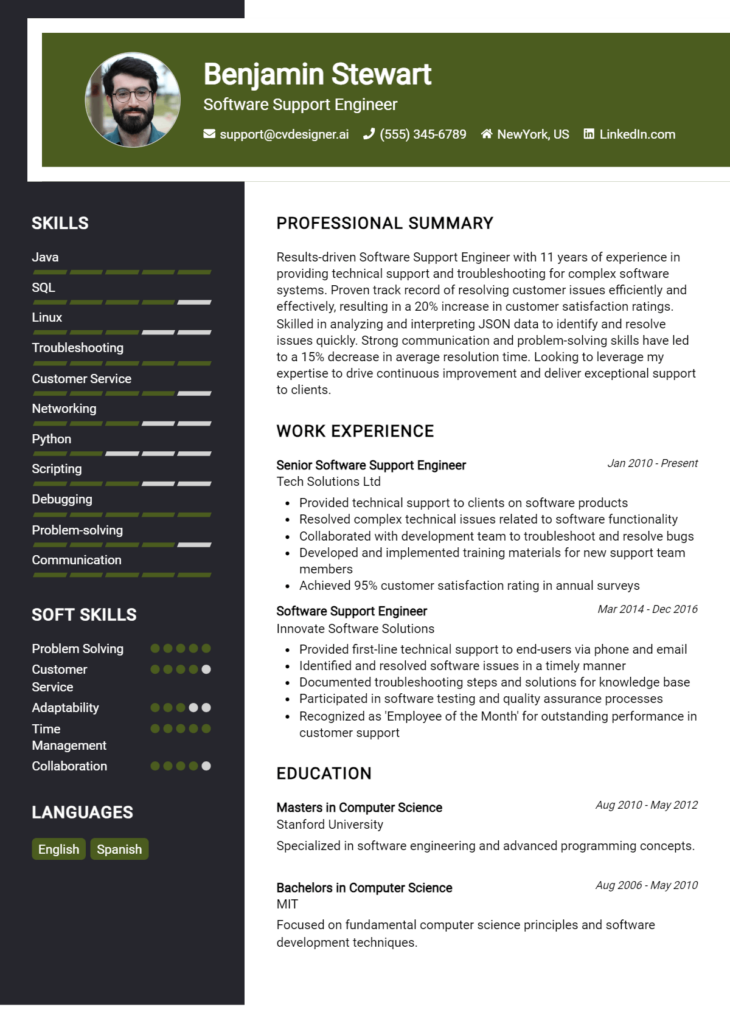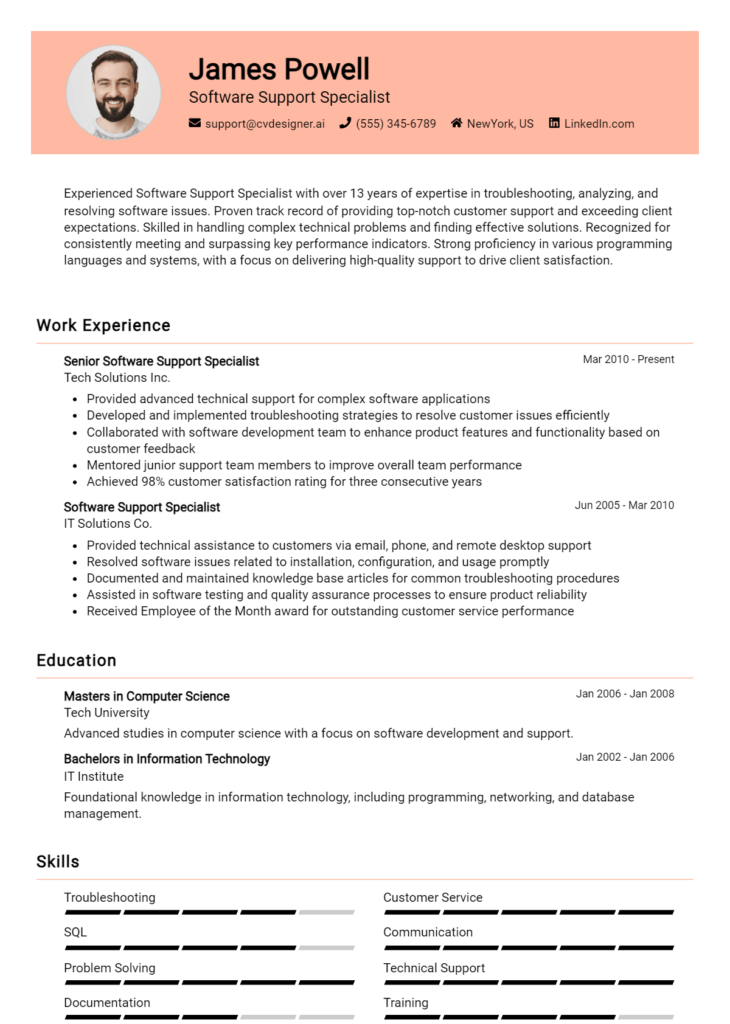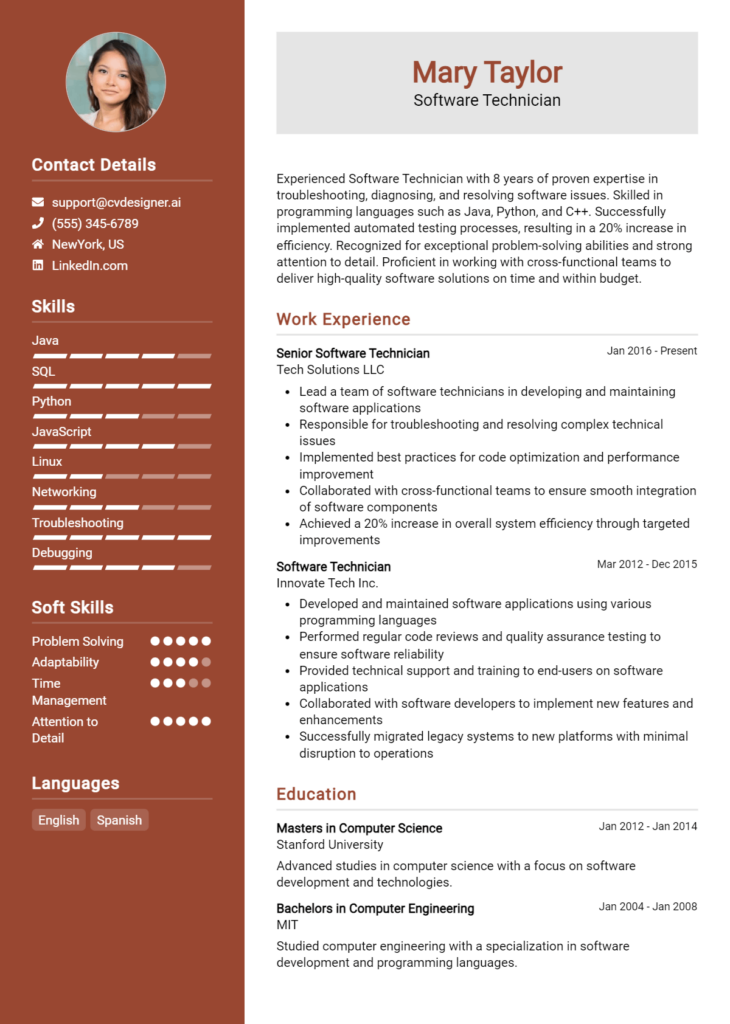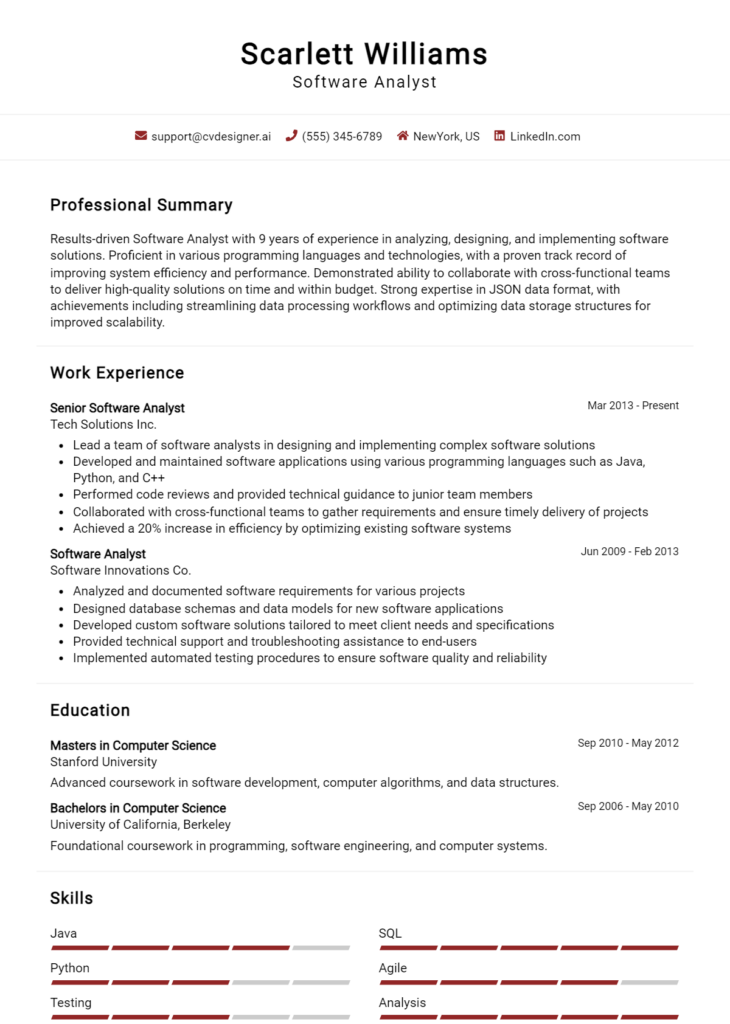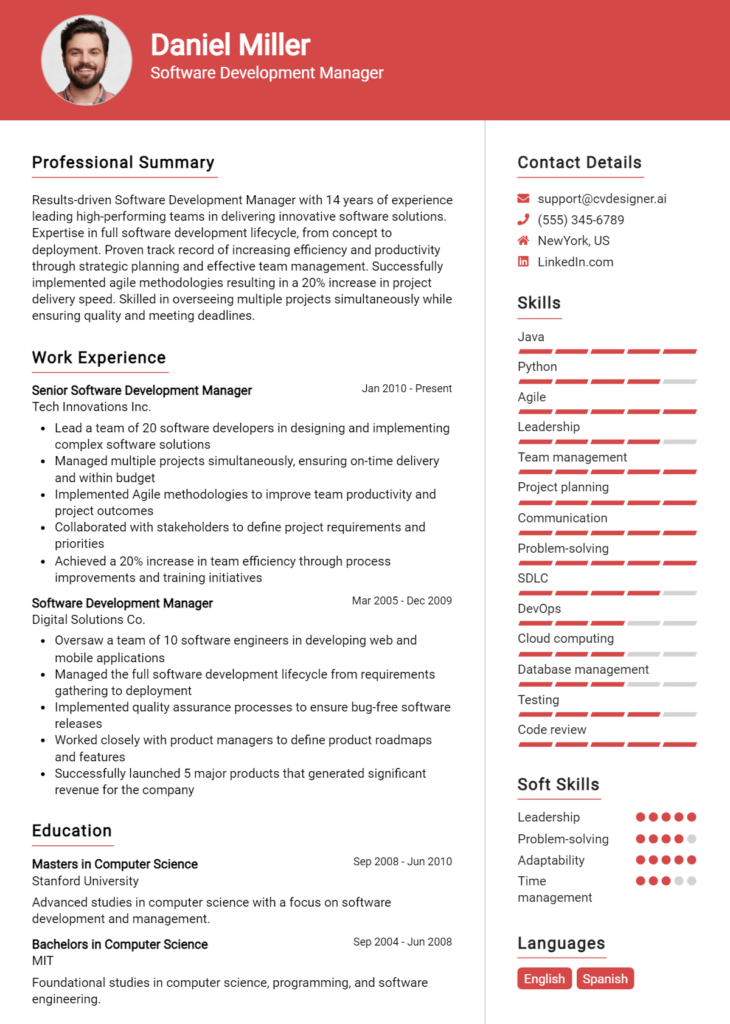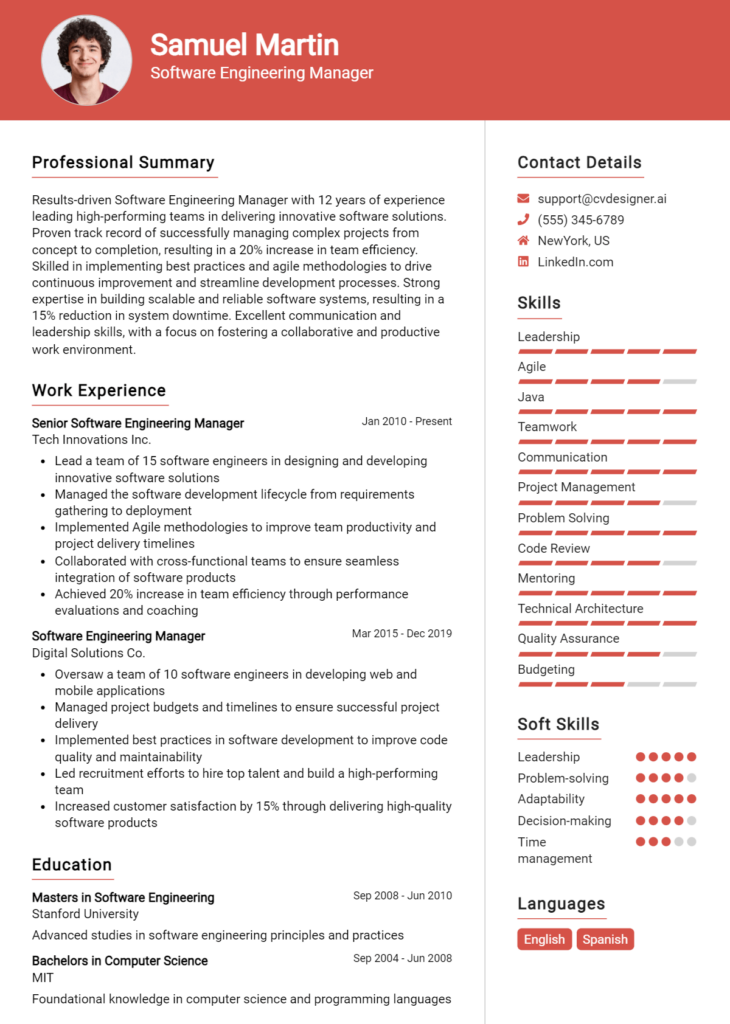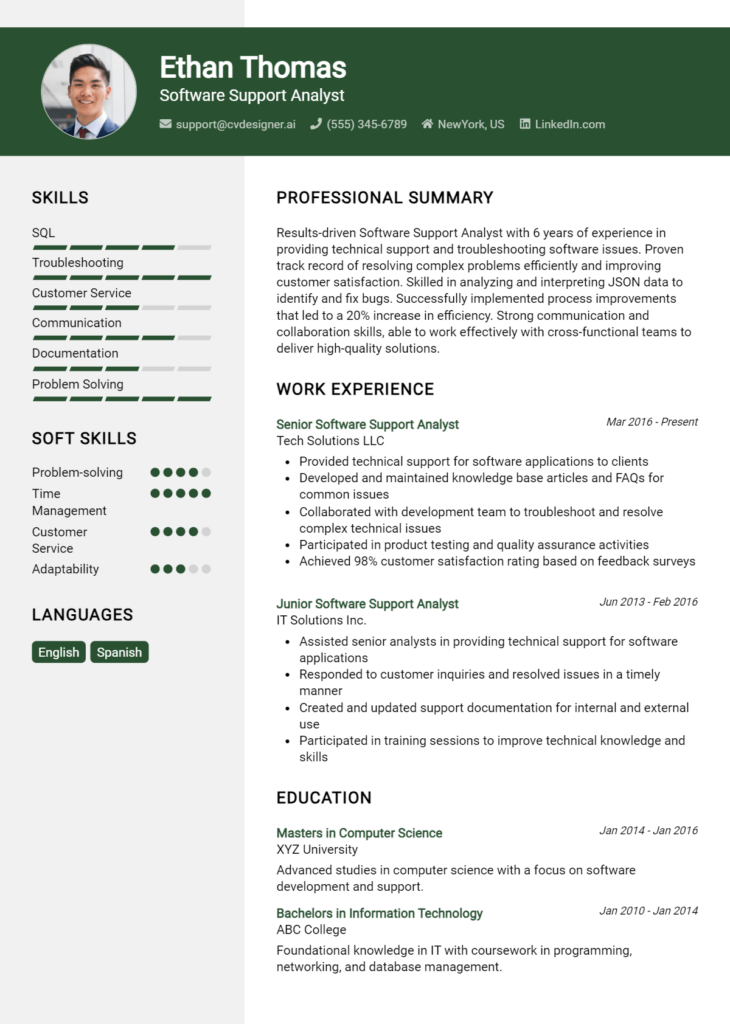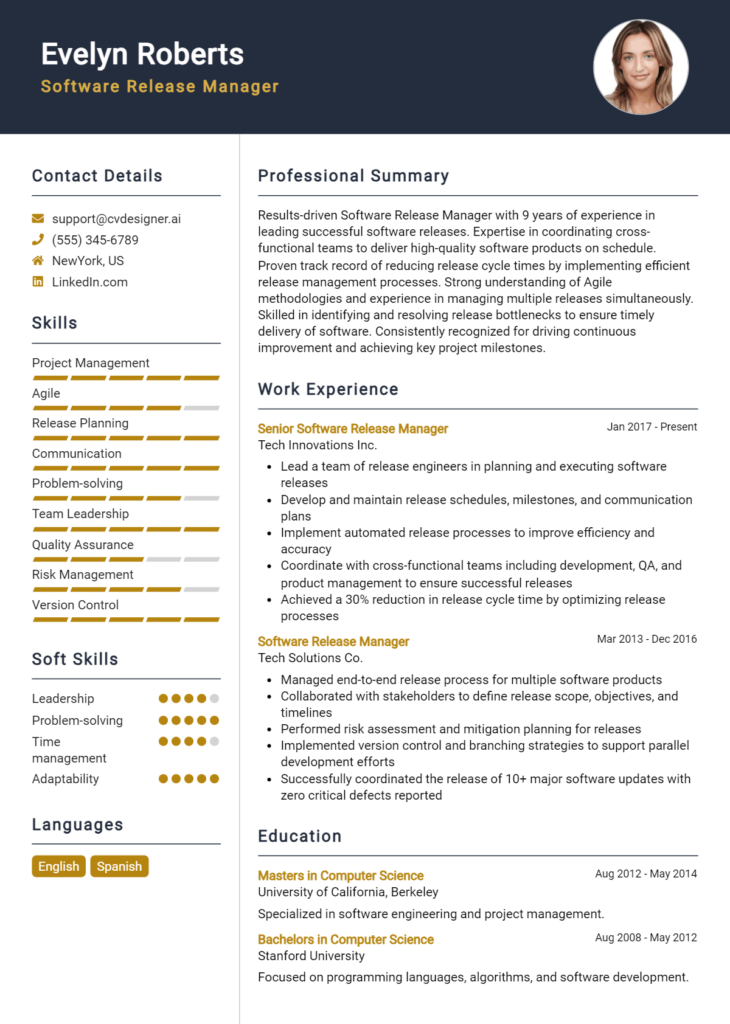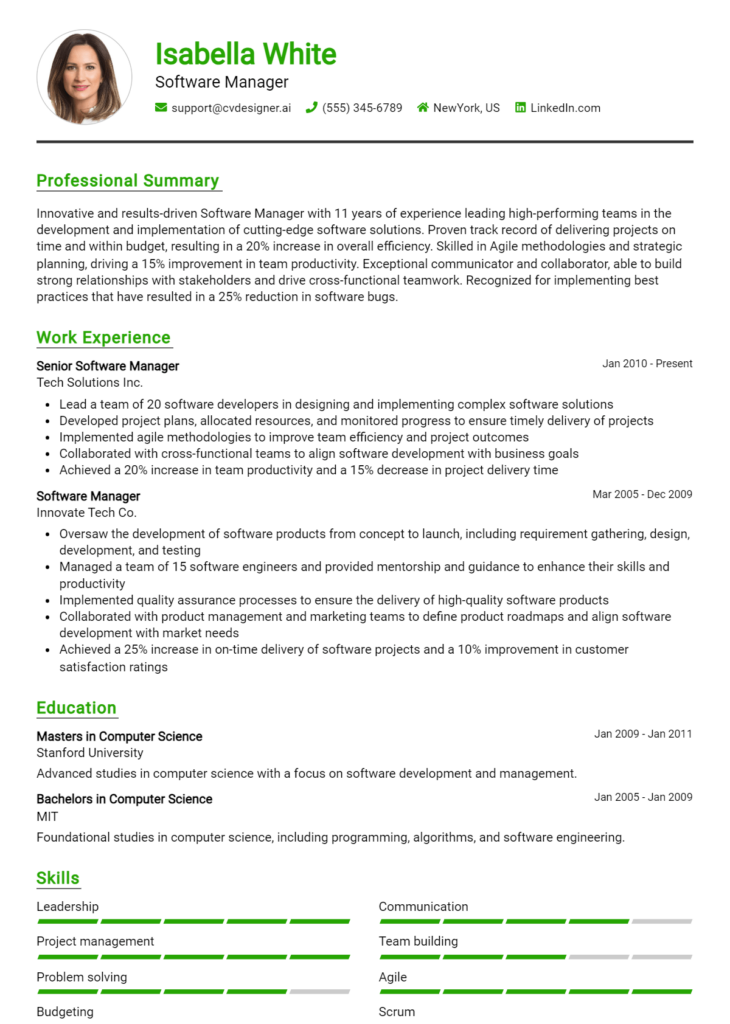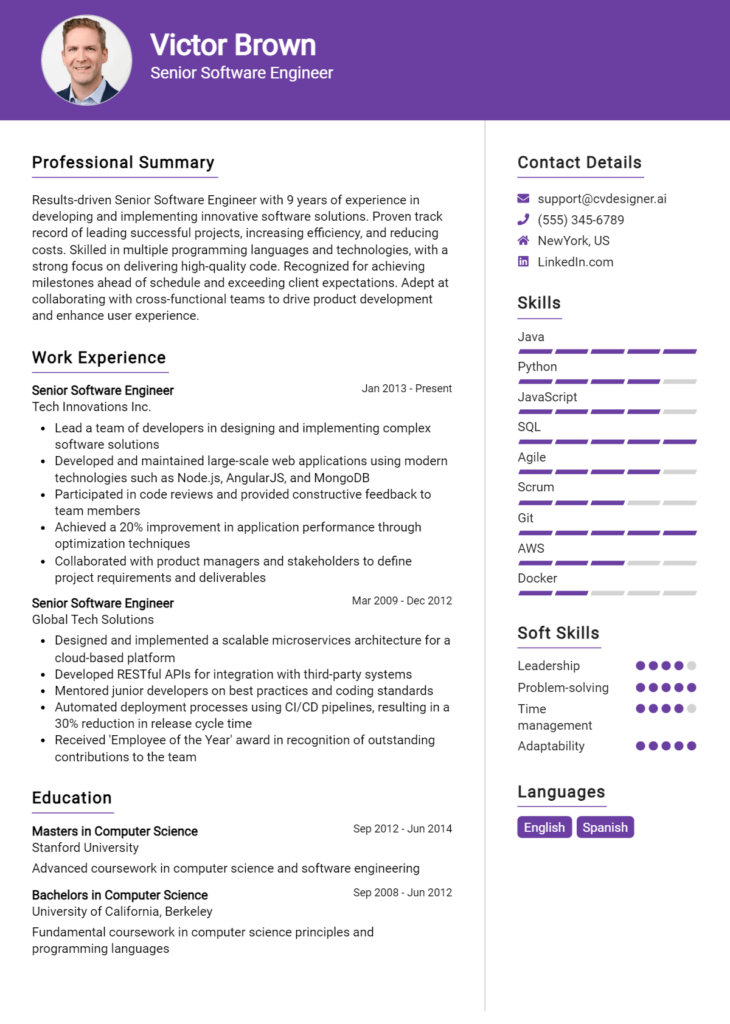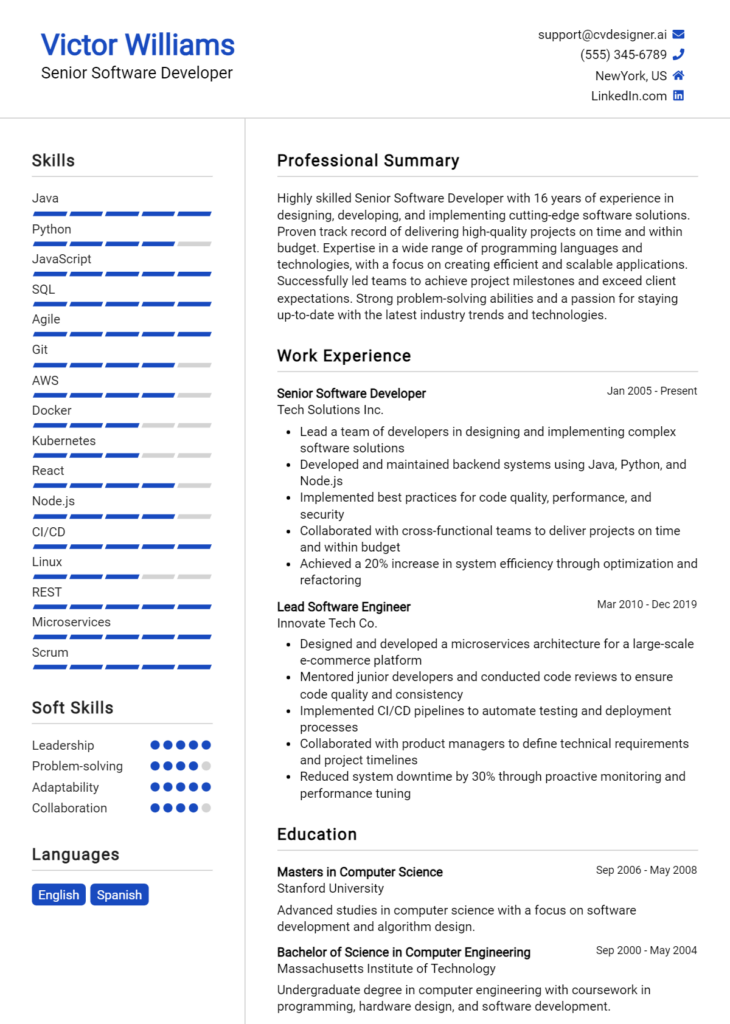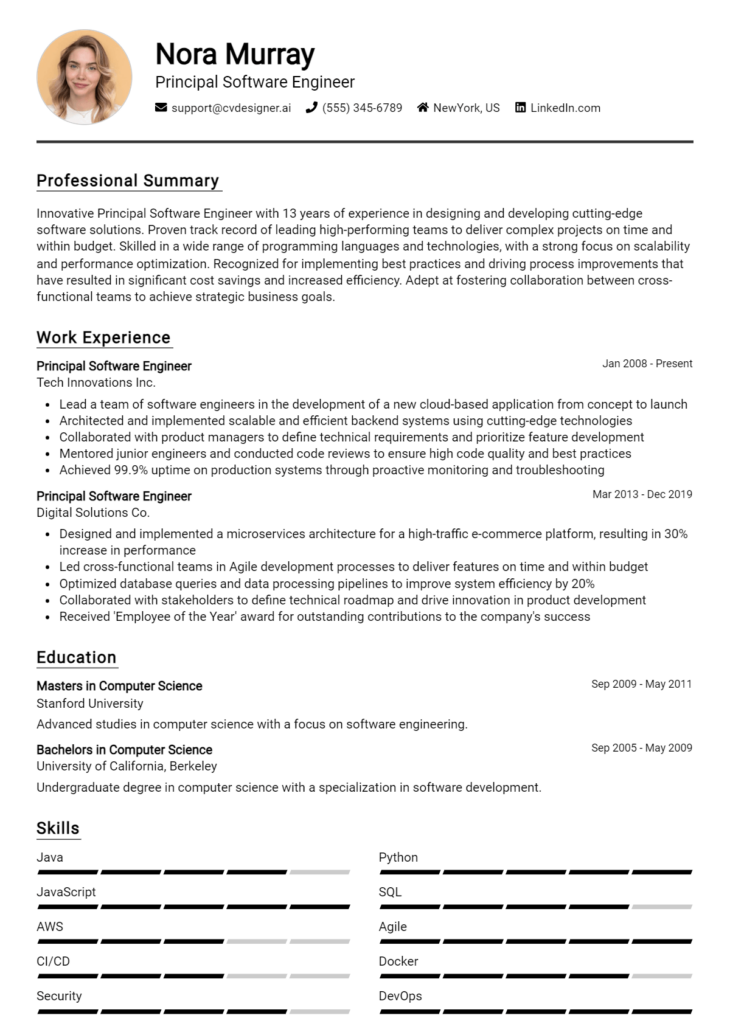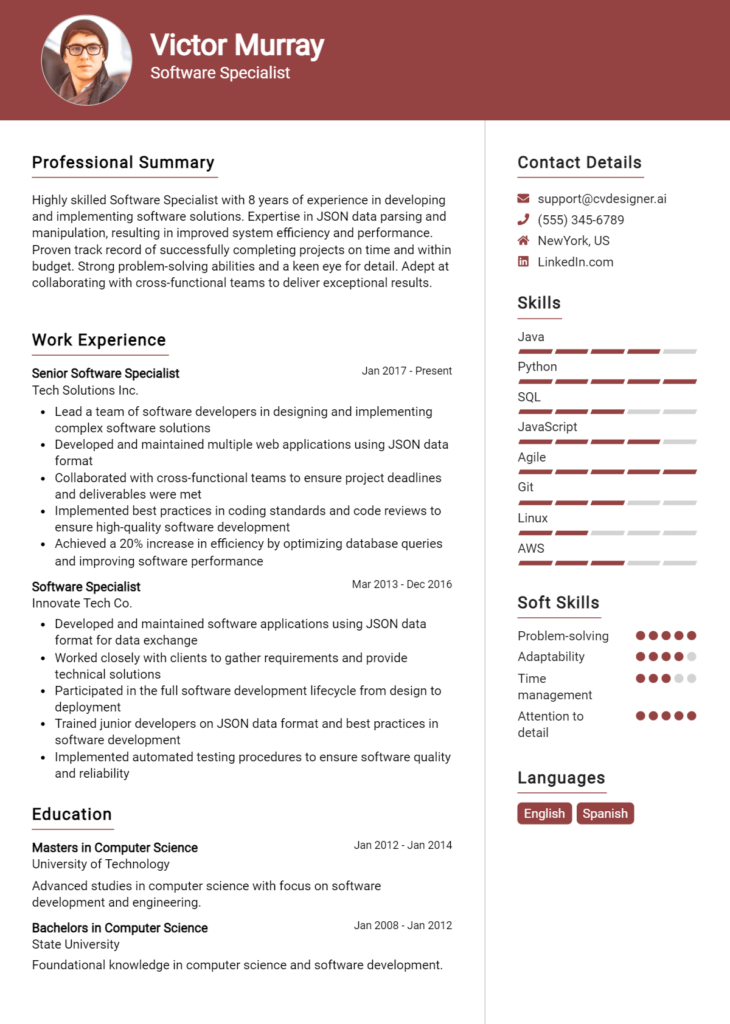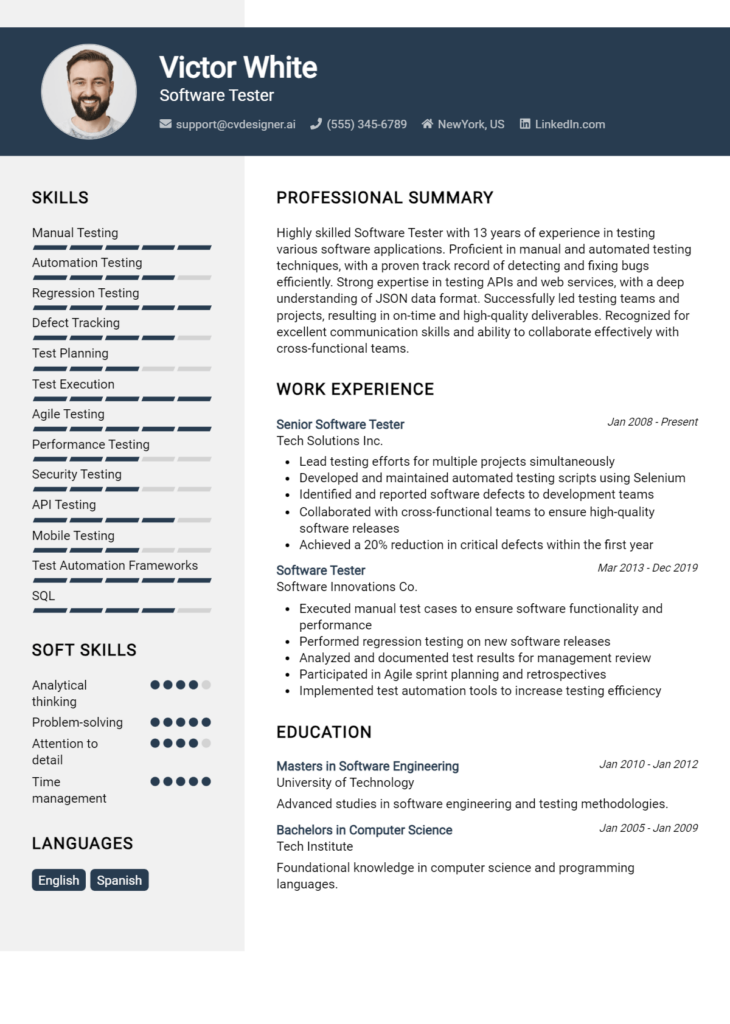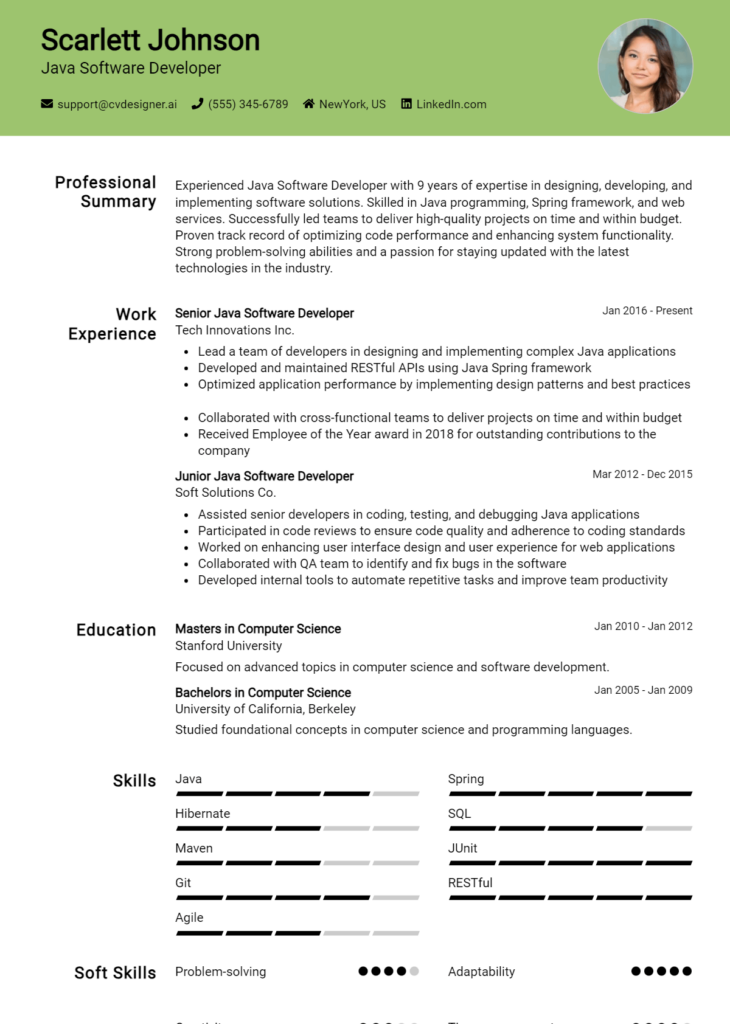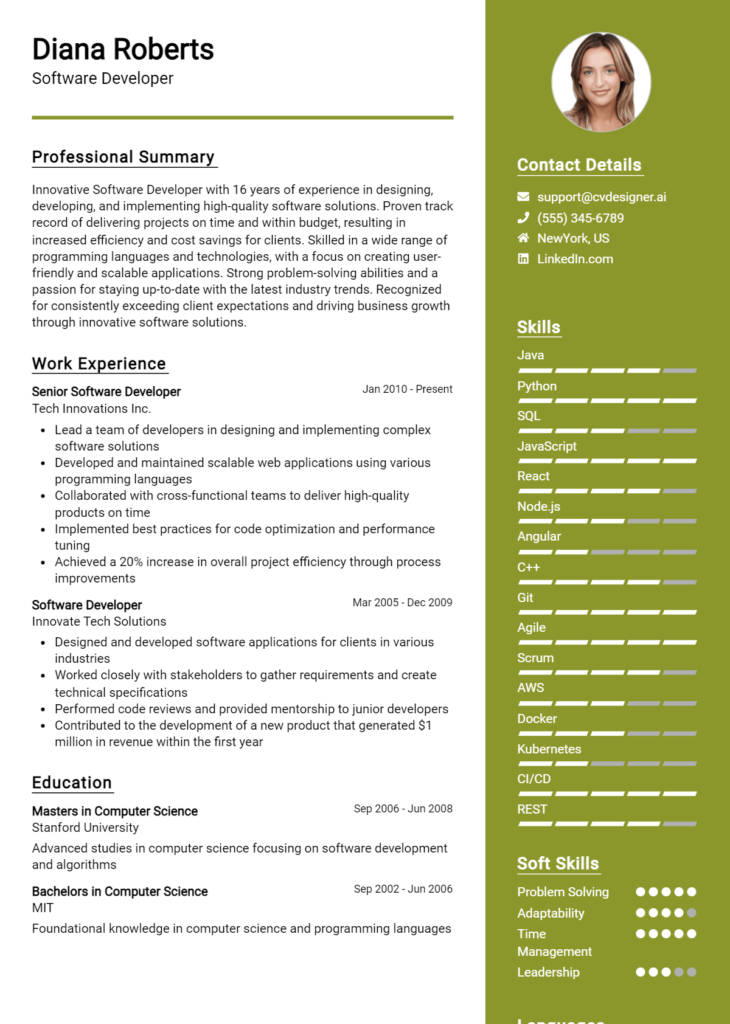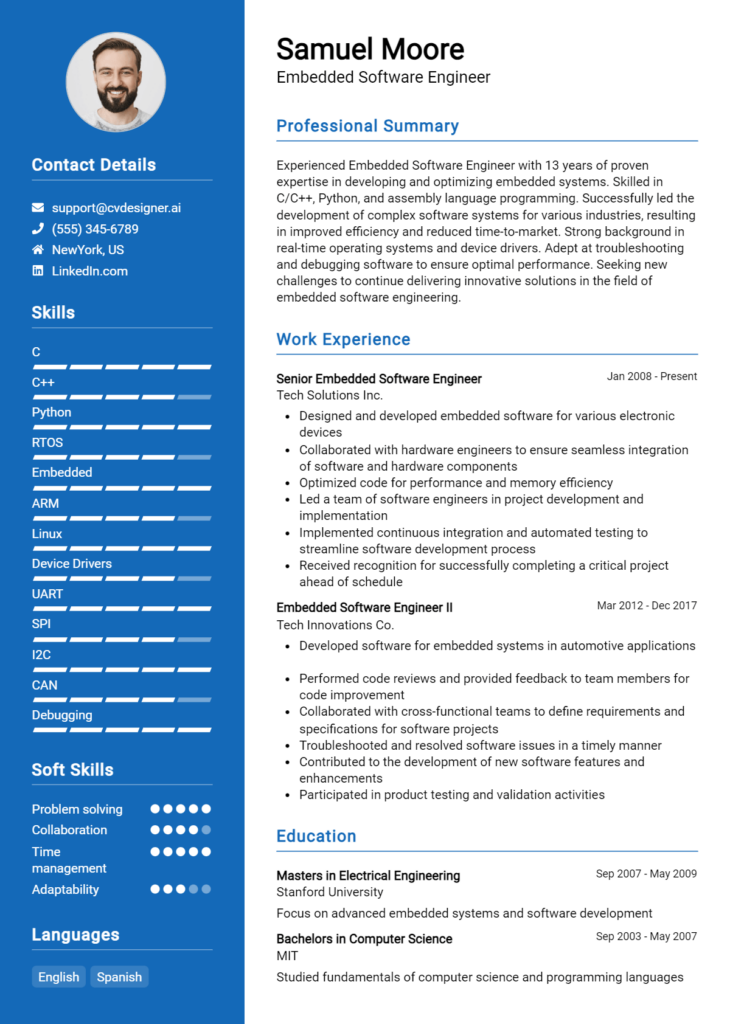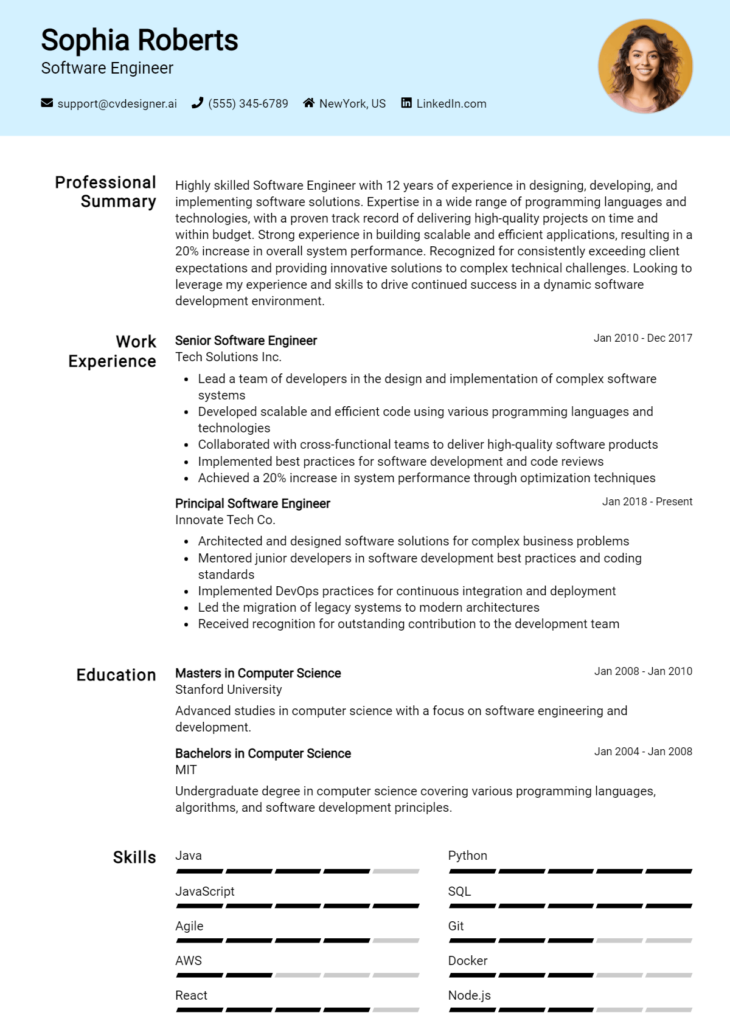Most Popular Software Development Engineer Resume Examples
Explore additional Software Development Engineer resume samples and guides and see what works for your level of experience or role.
As the tech industry continues to flourish, the role of a Software Development Engineer (SDE) has become increasingly vital. These professionals are not only responsible for designing, coding, and testing software applications but also play a crucial role in solving complex problems and driving innovation. In a competitive job market, having a well-crafted resume is essential to stand out from the crowd and showcase your skills and experiences effectively. A strong resume can open doors to exciting opportunities and is often the first impression potential employers have of you.
In this comprehensive guide, we'll delve into the key elements of creating a standout Software Development Engineer resume. You’ll learn about the core responsibilities and skills that hiring managers look for, the best formats to use for maximum impact, and the common mistakes that could undermine your chances of getting noticed. We’ll provide resume examples tailored for different experience levels, along with practical tips on how to craft your resume effectively. Additionally, we’ll guide you in selecting the right resume templates to enhance your presentation. Whether you’re a seasoned professional or just starting out, this guide will equip you with the insights needed to create a compelling resume that resonates with employers.
Key Responsibilities and Skills for a Software Development Engineer
A Software Development Engineer (SDE) plays a crucial role in the design, development, testing, and maintenance of software applications. SDEs work collaboratively with cross-functional teams to gather requirements, analyze user needs, and develop innovative solutions that enhance user experience and improve system functionality. Their responsibilities often include writing clean, maintainable code, debugging and resolving software defects, and continuously improving processes to optimize performance.
Key Responsibilities:
- Design, develop, and deploy scalable software applications.
- Collaborate with product managers and other stakeholders to define software requirements.
- Conduct code reviews to ensure code quality and adherence to best practices.
- Test and debug software applications to ensure high-quality deliverables.
- Maintain documentation for software designs, processes, and user guides.
- Stay updated with emerging technologies and industry trends to implement innovative solutions.
Essential Skills:
- Proficiency in programming languages (e.g., Java, Python, C++).
- Strong understanding of data structures and algorithms.
- Experience with software development methodologies (e.g., Agile, Scrum).
- Familiarity with version control systems (e.g., Git).
- Ability to troubleshoot and optimize code performance.
- Excellent problem-solving and analytical skills.
- Strong communication and collaboration abilities.
Highlighting these skills effectively in the resume skills section is vital for standing out in a competitive job market. Tailoring these responsibilities and skills to align with the specific job description ensures that your application resonates with hiring managers and applicant tracking systems. Additionally, consider how these skills can be presented in your CV to showcase your strengths and relevance to potential employers, making a compelling case for your candidacy.
Best Resume Format and Structure for a Software Development Engineer
When crafting a resume for a Software Development Engineer position, it's crucial to choose a format that highlights your technical skills and experience while ensuring clarity and professionalism. Below is a comprehensive guide to the best resume format and structure for this role.
Contact Information
- Name: Your full name at the top, prominently displayed.
- Phone Number: A reliable contact number.
- Email Address: Use a professional email, ideally a variation of your name.
- LinkedIn Profile: Include a link to your LinkedIn profile, ensuring it's up-to-date.
- GitHub/Portfolio: If applicable, add links to your GitHub or personal portfolio showcasing your projects.
Professional Summary
- Begin with a brief summary (2-4 sentences) that encapsulates your experience, key skills, and what you bring to the table. Tailor this section to reflect the specific job you're applying for.
- Focus on your years of experience, primary programming languages, and any notable achievements or projects.
Work Experience
- Job Title | Company Name | Location | Dates of Employment
- Use bullet points to describe your responsibilities and achievements in each role.
- Focus on quantifiable achievements (e.g., “Improved application performance by 20%”).
- Highlight specific technologies and methodologies you used (e.g., Agile, Scrum).
- Tailor the content to emphasize your most relevant experiences for the job you are applying for.
Education
- Degree | Major | Institution Name | Location | Graduation Date
- Include relevant coursework or projects if you’re a recent graduate.
- Mention honors or awards if applicable.
Skills
- Create a separate section to list relevant technical skills. Use bullet points or a simple table.
- Include programming languages, frameworks, tools, and methodologies.
- Be honest and ensure you can back up your skills during an interview.
Certifications
- List any relevant certifications that enhance your qualifications (e.g., AWS Certified Developer, Microsoft Certified: Azure Developer Associate).
- Include the certification name, the issuing organization, and the date obtained.
Tips for Choosing the Right Format
- Chronological Format: This is the most common and effective format for Software Development Engineers, allowing you to showcase your career progression.
- Clean Layout: Use clear headings and ample white space to ensure readability.
- Font and Size: Use professional fonts like Arial, Calibri, or Times New Roman in sizes 10-12 for body text, and slightly larger for headings.
- Length: Keep your resume to one page if you have less than 10 years of experience; two pages are acceptable for more extensive experience.
Complementing Cover Letter Format
A well-structured resume works hand-in-hand with a corresponding cover letter. Ensure that both documents reflect your personal brand and are tailored to the job you’re applying for.
- Introduction: In your cover letter, briefly introduce yourself and mention the position you’re applying for, similar to your professional summary.
- Body: Use the body of the cover letter to elaborate on key experiences mentioned in your resume, providing context and demonstrating your enthusiasm for the role.
- Conclusion: End with a strong closing statement that encourages a follow-up, mirroring the professionalism of your resume.
By adhering to this structure, you’ll create a compelling resume that effectively showcases your qualifications as a Software Development Engineer and complements your cover letter.
Writing Tips and Best Practices for a Software Development Engineer Resume
When crafting a resume as a Software Development Engineer, it's crucial to present your technical skills and experiences in a clear and compelling manner. Focus on tailoring your resume to highlight relevant projects and accomplishments that align with the job description. Use a clean layout that is easy to read, and ensure that your contact information is prominently displayed. Remember that hiring managers often skim through resumes, so making your most significant achievements stand out is essential. Additionally, utilizing resume writing tips can help you achieve a professional look that captures attention. Consider how these practices also apply when drafting a cover letter to further emphasize your qualifications.
- Use action verbs to start bullet points, such as "developed," "designed," or "implemented," to convey your active role in projects.
- Quantify your achievements with specific metrics, such as "increased application performance by 30%" or "reduced bug counts by 15%."
- Incorporate industry-specific keywords that match the job description to improve your chances of passing Applicant Tracking Systems (ATS).
- Highlight relevant programming languages, frameworks, and tools prominently in a skills section or within your experience descriptions.
- Tailor your resume for each application, ensuring that you emphasize the skills and experiences that are most relevant to the specific role.
- Include a summary statement at the top of your resume that succinctly captures your professional identity and key qualifications.
- Use concise and clear language throughout your resume to maintain readability and ensure that your key points are easily understood.
- Proofread your resume multiple times to eliminate any grammatical errors or typos, as attention to detail is critical in software development.
Common Mistakes to Avoid in a Software Development Engineer Resume
Crafting a compelling resume is crucial for Software Development Engineers to stand out in a competitive job market. However, many candidates make common mistakes that can hinder their chances of landing an interview. By avoiding these pitfalls, you can present a clear and professional image that highlights your skills and experiences effectively. Below are some common mistakes to steer clear of when creating your resume:
- Overloading with Information: Including excessive details can overwhelm hiring managers. Keep your resume concise and relevant.
- Using Generic Descriptions: Vague statements do not showcase your unique skills. Tailor your descriptions to reflect specific accomplishments and technologies used.
- Neglecting Formatting: A cluttered or inconsistent format can distract from your qualifications. Use clear headings and consistent font styles.
- Ignoring Keywords: Failing to incorporate industry-specific keywords can reduce your chances of passing through Applicant Tracking Systems (ATS).
- Listing Responsibilities Instead of Achievements: Focus on what you accomplished in your roles rather than just listing your duties.
- Omitting Relevant Projects: Highlight personal or freelance projects that demonstrate your skills, especially if you lack extensive professional experience.
- Not Proofreading: Typos and grammatical errors can create a negative impression. Always proofread your resume before submitting.
- Including Irrelevant Information: Avoid adding hobbies or experiences that do not relate to the job you are applying for.
- Using an Unprofessional Email Address: Ensure your contact details reflect professionalism to make a good first impression.
For a more comprehensive guide on avoiding common mistakes, consider reviewing the common mistakes to avoid in a resume. Additionally, don't forget to check out the common cover letter mistakes that should also be avoided to strengthen your application further.
Sample Software Development Engineer Resumes
As a Software Development Engineer, crafting a compelling resume is crucial to showcase your skills and experience to potential employers. Whether you're an experienced professional, an entry-level candidate, or someone transitioning from a different career, your resume should highlight relevant technical abilities, projects, and achievements. Below are three sample resumes tailored for different career stages.
Experienced Software Development Engineer
John Doe
123 Tech Lane
San Francisco, CA 94101
(555) 123-4567
john.doe@email.com
Professional Summary
Results-driven Software Development Engineer with over 8 years of experience in designing, developing, and deploying scalable software solutions. Proficient in multiple programming languages and frameworks, with a strong background in agile methodologies and cloud computing.
Technical Skills
- Programming Languages: Java, Python, C++
- Web Technologies: React, Node.js, HTML/CSS
- Databases: MySQL, MongoDB
- Tools: Git, Docker, Jenkins
- Methodologies: Agile, Scrum
Professional Experience
Senior Software Engineer
Tech Innovations Inc., San Francisco, CA
March 2019 – Present
- Led a team of 5 developers to create a cloud-based platform, improving client satisfaction by 30%.
- Implemented CI/CD pipelines, reducing deployment time by 40%.
- Collaborated with cross-functional teams to define product requirements and deliver solutions on time.
Software Engineer
CodeCraft LLC, San Francisco, CA
June 2015 – February 2019
- Developed and maintained web applications using Java and Spring framework.
- Enhanced application performance by 25% through code optimization and refactoring.
- Participated in all phases of the software development lifecycle, adhering to best practices.
Education
Bachelor of Science in Computer Science
University of California, Berkeley
Graduated: May 2015
Entry-Level Software Development Engineer
Jane Smith
456 Developer Blvd
Austin, TX 78701
(555) 987-6543
jane.smith@email.com
Professional Summary
Motivated and detail-oriented recent Computer Science graduate with a solid foundation in software development principles and programming languages. Eager to contribute to a dynamic team and apply problem-solving skills in a real-world environment.
Technical Skills
- Programming Languages: Python, Java, JavaScript
- Web Technologies: HTML, CSS, React
- Tools: Git, Visual Studio Code
- Databases: SQLite
Education
Bachelor of Science in Computer Science
University of Texas at Austin
Graduated: May 2023
Internship Experience
Software Development Intern
InnovateTech Corp, Austin, TX
June 2022 – August 2022
- Assisted in the development of a web application using React and Node.js, enhancing user experience.
- Collaborated with senior developers to troubleshoot and resolve software defects.
- Participated in daily stand-ups and sprint planning sessions, gaining hands-on experience with Agile methodologies.
Career Changer to Software Development Engineer
Michael Johnson
789 New Path St
Seattle, WA 98101
(555) 654-3210
michael.johnson@email.com
Professional Summary
Detail-oriented professional with a background in project management transitioning to Software Development Engineering. Strong analytical skills and a passion for technology, seeking to leverage experience in team collaboration and problem-solving to build innovative software solutions.
Technical Skills
- Programming Languages: Java, C#, SQL
- Web Technologies: Angular, Bootstrap
- Tools: JIRA, Git, Visual Studio
- Methodologies: Agile, Waterfall
Professional Experience
Project Manager
Global Solutions Ltd., Seattle, WA
January 2018 – Present
- Managed software development projects from conception to deployment, ensuring timely delivery and adherence to quality standards.
- Coordinated with developers and stakeholders to gather requirements and provide technical specifications.
- Developed a strong understanding of software development processes and best practices.
Education
Certificate in Software Development
Codecademy
Completed: August 2023
Bachelor of Arts in Business Administration
University of Washington
Graduated: June 2017
For more inspiration, explore additional resume examples tailored to your specific needs. Additionally, don't forget that corresponding cover letter examples can help you create a complete job application package.
Checklist for a Software Development Engineer Resume
- Check for Spelling and Grammar Errors: Carefully proofread your resume for any typos, grammatical mistakes, or awkward phrasing. Utilize tools like Grammarly or other proofreading software to catch any errors.
- Ensure Consistency in Formatting: Verify that font types, sizes, and colors are consistent throughout your resume. This includes headers, bullet points, and spacing to create a professional appearance.
- Tailor Your Resume to the Job Description: Customize your resume to align with the specific job requirements. Highlight relevant skills and experiences that match the role of Software Development Engineer you are applying for.
- Use Action Verbs: Start bullet points with strong action verbs to convey your achievements and responsibilities effectively. Words like "developed," "designed," "implemented," and "optimized" can make a significant impact.
- Quantify Achievements: Whenever possible, include metrics and numbers to quantify your accomplishments. For example, "Improved application performance by 30%" or "Led a team of 5 developers."
- Highlight Relevant Skills: Ensure that your technical skills, programming languages, and tools are prominently displayed. Include both hard and soft skills that are pertinent to the Software Development Engineer role.
- Keep It Concise: Limit your resume to one or two pages. Avoid unnecessary details and focus on the most relevant experiences and skills that showcase your qualifications.
- Include a Summary Statement: Start your resume with a brief summary that encapsulates your professional background and what you bring to the table as a Software Development Engineer.
- Ask for Feedback: Have a peer or mentor review your resume for clarity and effectiveness. Fresh eyes can catch mistakes you might have overlooked and provide valuable insights.
- Consider Using an AI Resume Builder: To ensure all elements of your resume are well-organized and visually appealing, consider using an AI resume builder. This tool can help streamline the process and enhance the quality of your resume.
Remember, a similar checklist can be followed for creating a CV, ensuring you present your qualifications clearly and professionally.
Key Takeaways for a Software Development Engineer Resume Guide
In conclusion, crafting a compelling Software Development Engineer resume is crucial for standing out in today's competitive job market. By utilizing the examples and tips provided in this guide, you can effectively highlight your technical skills, project experience, and problem-solving abilities. Remember, a well-structured resume not only showcases your qualifications but also reflects your professionalism. As a next step, consider downloading a customizable template from resume templates to streamline your writing process. Additionally, if you need assistance with your application materials, explore our cover letter templates or take advantage of our user-friendly resume maker to create an impactful resume that gets you noticed. Start your journey toward securing your dream job today!
